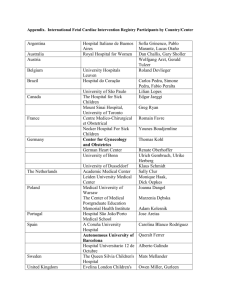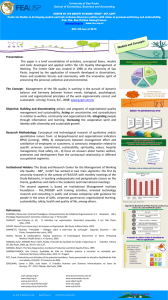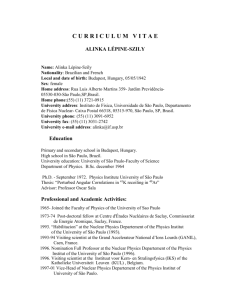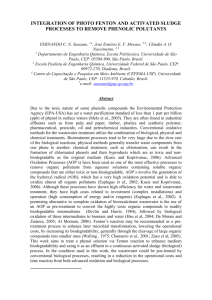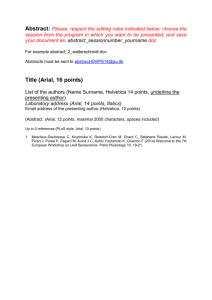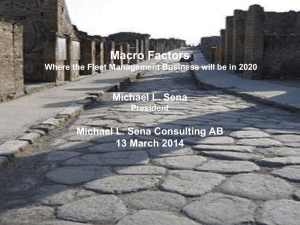Guidelines for submitting Full paper to 15 th NOCMAT
advertisement
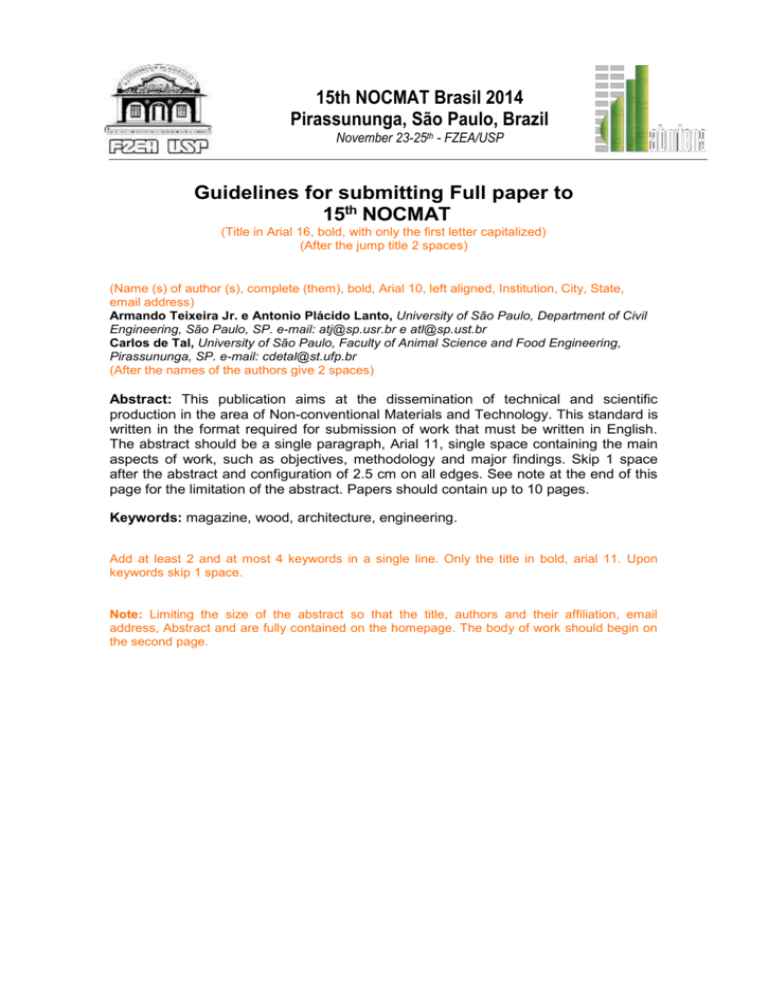
15th NOCMAT Brasil 2014 Pirassununga, São Paulo, Brazil November 23-25th - FZEA/USP Guidelines for submitting Full paper to 15th NOCMAT (Title in Arial 16, bold, with only the first letter capitalized) (After the jump title 2 spaces) (Name (s) of author (s), complete (them), bold, Arial 10, left aligned, Institution, City, State, email address) Armando Teixeira Jr. e Antonio Plácido Lanto, University of São Paulo, Department of Civil Engineering, São Paulo, SP. e-mail: atj@sp.usr.br e atl@sp.ust.br Carlos de Tal, University of São Paulo, Faculty of Animal Science and Food Engineering, Pirassununga, SP. e-mail: cdetal@st.ufp.br (After the names of the authors give 2 spaces) Abstract: This publication aims at the dissemination of technical and scientific production in the area of Non-conventional Materials and Technology. This standard is written in the format required for submission of work that must be written in English. The abstract should be a single paragraph, Arial 11, single space containing the main aspects of work, such as objectives, methodology and major findings. Skip 1 space after the abstract and configuration of 2.5 cm on all edges. See note at the end of this page for the limitation of the abstract. Papers should contain up to 10 pages. Keywords: magazine, wood, architecture, engineering. Add at least 2 and at most 4 keywords in a single line. Only the title in bold, arial 11. Upon keywords skip 1 space. Note: Limiting the size of the abstract so that the title, authors and their affiliation, email address, Abstract and are fully contained on the homepage. The body of work should begin on the second page. 1. Introduction The contents of chapter should be technical and / or scientific theoretical, numerical or experimental nature, or even literature reviews with up to 25 pages. The subject matter of work should be restricted to the scope of the book, previously registered. As an editor, using Word for Windows 7 or higher. 2. Formatting 2.1. Configuration Setting A4 (297mm x 210mm), with all margins of 2.5 cm. Paragraphs should be written in single, justified, and with 1.5 line spacing column. Pages should not be numbered. The headings, subheadings, body of work and references will be in Arial 11. Titles and subtitles are in bold. Before and after each title and subtitle skip a space. 2.2 Figures The format of the figure is exemplified in Fig. 1. Figure 1 – SEMxxxx. Fonte: Pinto (2005). (Among the figure title and put a space size 8) The titles, references and text boxes in the figures should be in Arial 10. Figure captions should be centered directly below, as Figure 1 - ....; Figure 2 - ... and your calls should be abbreviated in the text: Fig. one; Figure 2. Figures should be scanned in color or black and white, with a resolution equal to or greater than 300 dpi (dots per inch) in JPEG format. Figures should be mandatorily inserted in the document. 2.3. Tables The titles of the tables must be centered on the page, immediately above, as Table 1 ...; Table 2 - ... and your calls should be abbreviated in the text: tab. one; tab. 2. Units should be used in the international system (SI) unless a source is quoted in another system. In tab. 1 we have an example of the presentation of the tables. Table 1 – Basic wood density of 10 logs for making panels. Number of log Basic density (g/cm³) 1 3 4 5 6 7 8 9 10 0,477 0,497 0,532 0,508 0,497 0,476 0,528 0,474 0,475 Average 0,493 2.4. Equation Equations should be typed using the equation tool in Word or formatted with numbers, texts and set in Arial 11, and 11 variables in Arial italic, subscript and superscript in Arial 7, sub-subscribed and under-5 overwritten in Arial, Symbol . symbol in 18 and sub -12 symbol symbol should be aligned left with their numbering aligned in the right way (1) and his calling in the text should be in the short form: eq. one; Eq. 2. An example on how to present the equations is presented in eq. 1, the apparent density. t mxc , (2.5) where: t = time in minutes; x c = thickness of the carbonized layer from the original surface; m = carbonized rate. Skip a space before and after each figure, table and equation. 2.5. References The references in the text, indicated by Arabic numerals in parentheses and superscript, correspond to a numbered list at the end of the article. Ex: Hellmeister (1983) (1) stated that the volume of the body of the specimen can be obtained from measurements with calipers, displacement ... In quotations, when the work has up to three authors, mention all and, when four or more, refer to the first followed by et al., In italics. The order in the reference list will be: Author (s) (year). Title (in italics). Edition (3.ed.). Publication (book, journal, etc..). Location. Volume (v.2), Number (n.5), Part (Part VII), Chapter (Cap.17), Page (p.205-213 or 102p.). Papers presented in proceedings (1) Hellmeister, J.C. (1983). Madeiras e suas características. In: ENCONTRO BRASILEIRO EM MADEIRAS E EM ESTRUTURAS DE MADEIRA, 1, São Carlos, 1983. Anais. São Paulo, USP, EESC, SET, LaMEM, v.1, p.1-37. Dissertations and Theses (2) Baraldi, L.T. (1996). Método de ensaio de ligações em estruturas de madeira por chapas com dentes estampados. São Carlos. 98 p. Dissertação (Mestrado) - Escola de Engenharia de São Carlos, Universidade de São Paulo. (3) Nascimento, M.F. (2003). CPH – Chapas de Partículas homogêneas – Madeiras do Nordeste do Brasil. São Carlos. 134p. Tese (Doutorado) - Escola de Engenharia de São Carlos, Universidade de São Paulo. www (world wide web) Autor (se conhecido). (Ano). Título (em itálico). Endereço. (Data de acesso). (4) Richard, F.B. (2004). Breaking New Ground. The forest industry quest for public acceptance. http://www.forestprod.org/04-Jan.pdf. (05 de abril). Books (5) Gonçalves, M.T.T. (2000). Processamento da madeira. 1.ed. Bauru, São Paulo, Document Center Xerox, 242p. Standards (6) Associação Brasileira de Normas Técnicas (1997). NBR 7190 – Projeto de estruturas de madeira. São Paulo. 107p. 3. Thanks Can complement the author's affiliation with the funding body of this research. Thanks may be placed after the conclusion and before the references. 4. Permission for publication It is the responsibility of the author (s) the citation of organs and / or institutions as well as the content of their articles, and editors and visual designers reserved the right to modify the presentation of figures, tables and equations aiming to standardize the text


